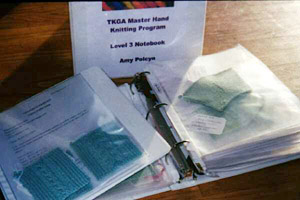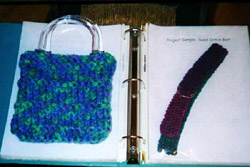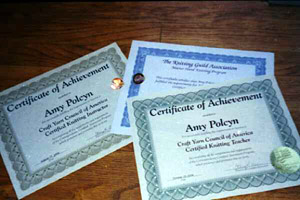TKGA's Master Hand Knitting Program (3 Levels)
In the fall of 2003, I
decided to embark on the path to Master
Knitterdom. Sure, I wanted to advance my
skills, but what my egocentric little mind
really wanted was the coveted "Master
Knitter" pin and certificate. So I
joined TKGA (a requirement to be in the
program) and sent in my money, currently
$30 for Level 1. A week later, I received
a folder containing a photocopied packet
of instructions. I was ready to go!
Essentially, each level
requires the knitter to produce a series
of swatches illustrating various techniques.
The program begins at Level 1 with simple
stockinette, ribbing, decreases, etc. and
progress to entrelac, traveling stitches,
smocking, and other more advanced techniques
by Level 3. In addition, participants are
asked to answer questions, write reports,
draft patterns, and in the upper two levels,
produce finished garments, including self-designed
Aran and Fair Isle/Scandinavian garments
in the final level. There is no time limit
for completion, but the most recent set
of program instructions must be followed.
(Free updates are available to participants.)

 I
was so motivated to finish Level 1 that
I got through it in only 9 days! Once I
had all of my swatches and written work
(16 swatches, 14 questions, and 1 report
for Level 1) organized in a binder, I mailed
it off to TKGA. About a month later, I heard
back from the review committee. I passed!
On to Level 2.
I
was so motivated to finish Level 1 that
I got through it in only 9 days! Once I
had all of my swatches and written work
(16 swatches, 14 questions, and 1 report
for Level 1) organized in a binder, I mailed
it off to TKGA. About a month later, I heard
back from the review committee. I passed!
On to Level 2.
Level 2 (21 swatches,
17 questions, 4 book reviews, 1 report,
1 vest, and 1 argyle sock) took considerably
longer to complete, mainly because of the
vest. I started in December of 2003 and
was finished the following July. I was elated.
Not only was I (almost) one step closer
to Master Knitter status, but I really improved
my skills, particularly with Fair Isle knitting
and seaming. Working carefully to ensure
my swatches would pass muster with the very
high standards of the committee meant I
had to rip out and start over a few times,
and practice techniques until I got them
right. It was also a great excuse to buy
some more knitting books! When my notebook
came back, I had a few corrections to make
to some of the patterns I wrote (I forgot
to include the metric needle size, among
others) before I could officially pass,
but thankfully I had nothing to reknit.
Currently, I am working
on Level 3, and hope to finish up this summer.
Working on the swatches in particular is
great for the warmer months, since they're
small and don't get hot and sweaty in your
lap. I have learned so much through the
program -- I now feel competent knitting
just about anything, and don't get put off
by even the trickiest of patterns. The best
part is that now I can design my own sweaters,
even complicated ones, something I was terrified
of before. Of course, I'm still looking
forward to "getting pinned" at
a TKGA conference once I pass the final
level!
CYCA's Correspondence Certified
Instructor's Program (3 Levels)
Okay, maybe I'm a glutton
for punishment (or my thirst for recognition
is really severe!) but this past summer,
I also enrolled in the CYCA Correspondence
Certified Instructor's Program. Am I planning
a career as a knitting teacher? Probably
not, but it would be nice to know I'm qualified
just in case. Plus, CYCA sends participants
a pin and certificate for each level, not
just at the end. Bonus!
In the CYCA program ($60
total for Levels 1 and 2) you are not required
to demonstrate as many knitting techniques
as the TKGA program, but you must show an
ability to write lesson plans and teach
others to knit. To help, CYCA sends you
a huge Instructor's Manual binder as well
as a book on how to teach knitting. Among
your assignments are knitting swatches,
designing sample projects, and writing lesson
plans. At each level you must also complete
15 hours (20 hours at Level 3) of student
teaching, which can be teaching a group
in a store or just teaching your niece in
your living room. There is a time limit
to complete each level (up to one year maximum
for Levels 1 and 2 combined.)

 In
Level 1, students knit sample swatches for
increases, decreases, basic cables, ribbing,
plus a self-designed beginner project and
pattern. It took me only about a week to
prepare all of the materials for Level 1,
but a bit longer to get through the student
teaching hours (luckily I have people around
me who want to learn!). The most important
lesson I learned trying to teach others
was that everyone has their own knitting
style, and the teacher must be able to adapt.
Good for me to learn, I'm sure! When I completed
my 15 hours, I sent my lesson plan binder
with my swatches and the beginner projects
I'd created to my teacher, designer Evie
Rosen. CYCA fancies a more intimate approach
to feedback, so students are asked to set
up "interview" appointments with
their teacher. The teacher asks the student
various questions to test their knowledge
of knitting and of teaching techniques,
as well as providing feedback on the submission.
In
Level 1, students knit sample swatches for
increases, decreases, basic cables, ribbing,
plus a self-designed beginner project and
pattern. It took me only about a week to
prepare all of the materials for Level 1,
but a bit longer to get through the student
teaching hours (luckily I have people around
me who want to learn!). The most important
lesson I learned trying to teach others
was that everyone has their own knitting
style, and the teacher must be able to adapt.
Good for me to learn, I'm sure! When I completed
my 15 hours, I sent my lesson plan binder
with my swatches and the beginner projects
I'd created to my teacher, designer Evie
Rosen. CYCA fancies a more intimate approach
to feedback, so students are asked to set
up "interview" appointments with
their teacher. The teacher asks the student
various questions to test their knowledge
of knitting and of teaching techniques,
as well as providing feedback on the submission.
I passed, and started
to work on Level 2. In this level, students
are asked to demonstrate short rows, colorwork,
buttonholes, and calculate and write an
original sweater pattern for an intermediate
knitter, design two beginner projects, and
write lesson plans for an intermediate-level
class. Students are also required to send
in a finished garment, though it does not
need to be self-designed, which of course
means you can send in a sweater you have
already knitted instead of having to knit
one especially for the program. Once again,
students contact their teacher for an exit
interview. In total, I completed both levels
in three months, and currently hold the
rank of Certified Knitting Teacher (with
a fancy pin and certificate to prove it!)

 I
might look into becoming a "Professional"
teacher by trying Level 3, but I want to
be a Master Knitter first. Then all shall
kneel trembling before me! The weak shall
fear my powerful needles! (Wait -- I probably
should have kept that to myself.)
I
might look into becoming a "Professional"
teacher by trying Level 3, but I want to
be a Master Knitter first. Then all shall
kneel trembling before me! The weak shall
fear my powerful needles! (Wait -- I probably
should have kept that to myself.)
Anyway, don't be afraid
of the ego trip that comes along with completing
either of these programs. It's good for
you AND your knitting. Especially your knitting.
Good luck!

